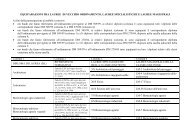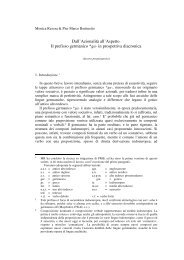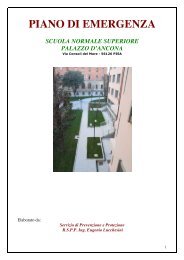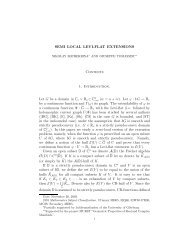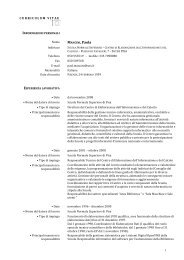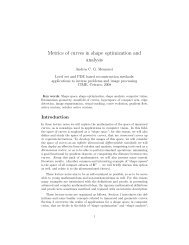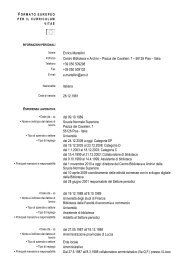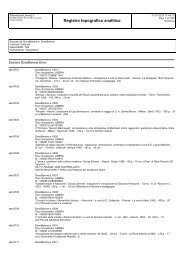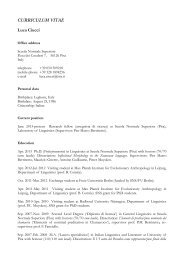4. Ghost [Å] vowels in French - Laboratorio di Linguistica
4. Ghost [Å] vowels in French - Laboratorio di Linguistica
4. Ghost [Å] vowels in French - Laboratorio di Linguistica
You also want an ePaper? Increase the reach of your titles
YUMPU automatically turns print PDFs into web optimized ePapers that Google loves.
<strong>4.</strong> <strong>Ghost</strong> [Œ] <strong>vowels</strong> <strong>in</strong> <strong>French</strong><strong>4.</strong>1. Discussion of the dataBe<strong>in</strong>g one of the ma<strong>in</strong> doma<strong>in</strong>s of phonological variation <strong>in</strong> <strong>French</strong>, together withliaison, the phenomenon tra<strong>di</strong>tionally referred to as '<strong>French</strong> E muet' or '<strong>French</strong> schwa'is often subjected to analyses that are based on heterogeneous data, i.e. data thatbelong to "qualitatively <strong>di</strong>fferent varieties of <strong>French</strong>" (Mor<strong>in</strong> 1987). There is oftenstrong <strong>di</strong>sagreement concern<strong>in</strong>g even the basic data on '<strong>French</strong> E muet'. Mor<strong>in</strong> (1987)po<strong>in</strong>ts out the risks that runs the phonologist who tackles the problem of <strong>French</strong>schwa:"Data on which recent theoretical analyses have been based are not always homogeneous. Evenstatistical surveys do not necessarily represent a coherent system […]. Often, analyses are based ontra<strong>di</strong>tional presentations to which new data are added, whose sources are rarely identified. […]Another source of <strong>di</strong>sagreement is what I called monitored <strong>French</strong>, which is analyzed on a par withother more tra<strong>di</strong>tional data. Its <strong>in</strong>terpretation is often presented as unambiguous, whereas duplicateexperiments show much more variability." (Mor<strong>in</strong> 1987:837-8).Mor<strong>in</strong> exemplifies the first typical misuse of data with Noske's earlier treatment of<strong>French</strong> schwa (Noske 1982) 1 based on markedness of syllable types: part of the datacontra<strong>di</strong>ct the tra<strong>di</strong>tional accounts of standard <strong>French</strong>. 2 In another article, Mor<strong>in</strong>(1988:252) cites Rialland's work (Rialland 1986) as provid<strong>in</strong>g data that are obta<strong>in</strong>ed<strong>in</strong> monitored experimental con<strong>di</strong>tions and "not yet <strong>in</strong>dependently supported". This isan <strong>in</strong>stance of the second typical misuse accord<strong>in</strong>g to Mor<strong>in</strong>. Thus, a problem withHyman's analysis of <strong>French</strong> schwa as a weightless vowel (Hyman 1985:60-64) couldbe that it is entirely based on Rialland's data.Some of the recent phonological developments based on <strong>French</strong> schwa take <strong>in</strong>toaccount specific varieties of <strong>French</strong>. Durand (1990:27-30), for <strong>in</strong>stance, is a standardgenerative treatment of schwa <strong>in</strong> Mi<strong>di</strong> <strong>French</strong>, while Durand (1995) accounts for thesame data 3 <strong>in</strong> a Dependency Phonology framework. The ma<strong>in</strong> work on <strong>French</strong> schwa1 The questionable data from Noske (1982) are abandoned <strong>in</strong> Noske's unified account for schwa andglid<strong>in</strong>g <strong>in</strong> <strong>French</strong> (Noske 1993:192-240).2 Noske assumes that schwa is deleted after a s<strong>in</strong>gle consonant (froidement), after a sequence'liquid+obstruent' (débarquement, sveltement) or '/s/+obstruent' (manifestement), but not after othersequences of two consonants (exactement).3 A detailed description of the data on schwa <strong>in</strong> Mi<strong>di</strong> <strong>French</strong> can be found <strong>in</strong> Durand, Slater & Wise1987.160
<strong>in</strong> the framework of Government Phonology - Charette's thesis (1988) - uses subsetsof data that are specific for the author's <strong>di</strong>alect of Quebec <strong>French</strong>: <strong>in</strong> some cases,reference to this variety is explicit (p.89, ex.14), <strong>in</strong> other cases, the significantdeviation from other authors' data for the Parisian varieties of <strong>French</strong> could beattributed to specific patterns of Quebec <strong>French</strong> (for <strong>in</strong>stance, p.117 ex.24 and p.339ex.8). A positive aspect of Scheer's analysis of <strong>French</strong> schwa (1996:330-358) is that itaccounts for two <strong>di</strong>fferent groups of <strong>French</strong> speakers: those that can realizefort(e)resse 'fortress' and le d(e)gré 'the degree' without a schwa (group A) and thosethat cannot (group B). Scheer is also aware of the existence of many ad<strong>di</strong>tionalsubgroups of speakers (Scheer 1996:336). The problem is that the empirical data onwhich the <strong>di</strong>st<strong>in</strong>ction of the two ma<strong>in</strong> varieties (A and B) has been done are not<strong>in</strong>cluded <strong>in</strong> Scheer's thesis.The analysis that I propose here is based on data from Dell (1985), the mostexhaustive description available <strong>in</strong> the literature on <strong>French</strong> schwa I know about, andsome ad<strong>di</strong>tional examples found <strong>in</strong> articles by the same author, namely Dell (1976),Dell (1978) and Dell (1984). Unfortunately, these data have not been tested byempirical <strong>in</strong>quiry with a larger group of speakers. The author says his goal is toprovide a thorough description of his own variety of <strong>French</strong>, be<strong>in</strong>g aware of the<strong>di</strong>sagreements that it will arouse:"Le comportement de schwa est l'un des doma<strong>in</strong>es où les variations d'un locuteur à l'autre sont trèsfréquentes, même entre gens dont les prononciations sont très semblables. Il est donc à prévoir quede nombreux lecteurs, même universitaires, parisiens, et de la même génération, se trouveront endésaccord sur un po<strong>in</strong>t ou sur un autre avec les données qui servent de base à notre <strong>di</strong>scussion."(Dell 1985:195)However, there is one advantage of Dell's data: they are homogeneous. The varietythey represent can be characterized as a rather 'conservative' (as Dell himselfrecognized <strong>in</strong> a personal communication) variety of the language spoken by educatedParisian speakers of standard <strong>French</strong>.The two most typical characteristics of this variety, as far as schwa is concerned, areformulated by Mor<strong>in</strong> (1987) as follows:• the phonetic <strong>di</strong>st<strong>in</strong>ction between nondeleted schwa and [Œ] 4 , the mid frontrounded vowel, has been neutralized (Mor<strong>in</strong> 1987:825);• schwa, i.e. alternat<strong>in</strong>g [Œ], does not delete when it is preceded by a group of twoconsonants word-<strong>in</strong>ternally, even when the result is syllabifiable (Mor<strong>in</strong>1987:835).4 The exact mean<strong>in</strong>g of the capital 'Œ' as phonetic symbol is given below .161
Dell's data on <strong>French</strong> schwa have been taken as a po<strong>in</strong>t of reference by some <strong>French</strong>speak<strong>in</strong>gphonologists look<strong>in</strong>g for a description of schwa <strong>in</strong> a variety of <strong>French</strong> that isclose to what they consider to be the "social norm". These data are the basis for thedescription of <strong>French</strong> 'E muet' <strong>in</strong> Tranel's The Sounds of <strong>French</strong> (1987), whose ma<strong>in</strong>goal is to teach standard pronunciation to foreign students of <strong>French</strong> phonetics. Whenspecify<strong>in</strong>g the behavior of schwa <strong>in</strong> the Sa<strong>in</strong>t-Etienne regional variety of <strong>French</strong>,Mor<strong>in</strong> (1983) also takes as a po<strong>in</strong>t of reference the variety of standard <strong>French</strong>described by Dell (1973). 5The variety described by Dell (1973, 1985) co<strong>in</strong>cides neither with group A nor withgroup B of Scheer (1996). Like group A it admits of schwa syncope <strong>in</strong> le d(e)gré 'thedegree' but like group B it prevents schwa from delet<strong>in</strong>g <strong>in</strong> fort(e)resse 'fortress'.<strong>4.</strong>1.1. The system of mid <strong>vowels</strong> <strong>in</strong> modern standard <strong>French</strong>Follow<strong>in</strong>g Wioland (1991), we assume that the Parisian variety of standard <strong>French</strong>neutralizes the opposition between mid-open and mid-close <strong>vowels</strong>, ɛ ~ e, ɔ ~ o andœ ~ ø, respectively, <strong>in</strong> syllables that Wioland refers to as "unstressable"("<strong>in</strong>accentuables"), namely those that never f<strong>in</strong>d themselves at the end of a rhythmicunit and, therefore, never receive f<strong>in</strong>al stress. However, many of these "unstressable"syllables can bear emphatic stress ("accent d'<strong>in</strong>sistance"). Given that <strong>in</strong> <strong>French</strong>emphatic stress is <strong>in</strong>compatible with lengthen<strong>in</strong>g (it uses only pitch and <strong>in</strong>tensity, tothe exclusion of duration, as perceptual cues, cf. Mertens 1987:85-88, Vaissière 1991)and that f<strong>in</strong>al stress systematically requires lengthen<strong>in</strong>g of the syllable, a moreadequate term for Wioland's "unstressable" would be "non lengthenable" syllables.Wioland assumes that the realizations of the mid <strong>vowels</strong> <strong>in</strong> closed "non lengthenable"syllables are rather open and recommends to transcribe them as [ɛ ], [ɔ], [œ]. As foropen "non lengthenable" syllables, the mid <strong>vowels</strong> that appear <strong>in</strong> them may cover arange of <strong>di</strong>fferent realizations from mid-close to mid-open and Wioland recommendsto transcribe them with the capital letters [E], [O], [Œ]. 6 <strong>French</strong> schwa is always5 "La description de Dell est la plus précise de toutes. Elle comporte un assez grand nombre de règlesqui peuvent être obligatoires ou facultatives; la chute ou l'épenthèse des e muets y est con<strong>di</strong>tionnée nonseulement par la suite des phonèmes en présence, mais aussi par la présence de frontières proso<strong>di</strong>ques(début et f<strong>in</strong> d'énoncé), de frontières de mots et de frontières morphologiques." (Mor<strong>in</strong> 1983:73)6 «L’oreille française, du fait de la rapi<strong>di</strong>té de l’articulation dans cette position peu importante, n’estpas sensible à une <strong>di</strong>fférenciation des timbres vocaliques respectifs. Aussi est-il pédagogiquementpréférable de transcrire respectivement par les archiphonèmes [O], [Œ] et [E] af<strong>in</strong> de ne pas donner à laprononciation de ces voyelles une importance qu’elles n’ont pas.» (Wioland 1991:82)162
found <strong>in</strong> an open "non lengthenable" syllable. The phonetic realization of nondeletedschwa co<strong>in</strong>cides with [Œ]. 7 Only where a closed syllable is created as a consequenceof the deletion of another schwa <strong>in</strong> the imme<strong>di</strong>ately follow<strong>in</strong>g syllable (see <strong>4.</strong>2.3.1),the realization of nondeleted schwa is mid-open [œ], e.g. je n(e) sais pas, with the firstschwa realized and the second schwa deleted, will be transcribed [.ʒœn.sɛ .pa.] with[œ] <strong>in</strong>stead of [Œ], because the non-realization of schwa <strong>in</strong> ne makes the preced<strong>in</strong>gsyllable closed.Table 1 below sums up the <strong>di</strong>fferent realizations of the mid <strong>vowels</strong> <strong>in</strong> all four syllabletypes. Where the opposition mid-close vs. mid-open is possible, I give both <strong>vowels</strong>related by '~'. In the cases of neutralization of the opposition, the actual realization ofthe respective mid vowel is given: mid-close (o, ø), mid-open (ɛ , ɔ, œ), or the wholerange from mid-close to mid-open (E, O, Œ).<strong>French</strong> mid<strong>vowels</strong>frontunroundedNon lengthenable Lengthenable syllablessyllablesClosed Open Closed Open” E ” e ~ ”back rounded O O O ~ o ofront rounded œ Œ œ ~ ø 8 øTable 1<strong>4.</strong>1.2. Alternat<strong>in</strong>g and non-alternat<strong>in</strong>g [Œ] <strong>in</strong> <strong>French</strong>I assume that, phonetically, nondeleted schwa (tra<strong>di</strong>tionally transcribed by means ofthe IPA symbol [E]) is not <strong>di</strong>fferent from the realization of the nonalternat<strong>in</strong>g midfront rounded <strong>vowels</strong> <strong>in</strong> open non lengthenable syllables: [Œ]. The <strong>di</strong>fference is thatschwa is a ghost [Œ] vowel, a vowel that alternates with zero. Not all [Œ] <strong>vowels</strong> <strong>in</strong><strong>French</strong> are <strong>in</strong>volved <strong>in</strong> vowel-zero alternations. Some of them are stable <strong>vowels</strong> andnever undergo syncope.7 «La graphie «e» suit donc les mêmes tendances générales de prononciation que les autres voyelles<strong>in</strong>accentuées à deux timbres et ne relève pas d’un cas particulier.» (Wioland 1991:82)8 [ø] is pronounced for 'eu' when the syllable is closed by [z] or [t]. Otherwise [œ] is pronounced.163
Accord<strong>in</strong>g to Tranel (1987:87), the two sequences given <strong>in</strong> (1a-b) below arehomophonous when the alternat<strong>in</strong>g [Œ] <strong>in</strong> (1a) is pronounced. Likewise, those <strong>in</strong> (2ab)are homophonous accord<strong>in</strong>g to Dell (1984:99) if the alternat<strong>in</strong>g [Œ] at the end ofautre is realized. The <strong>di</strong>fference is that the sequences <strong>in</strong> (1a) and (2a) conta<strong>in</strong> analternat<strong>in</strong>g [Œ] (respectively, <strong>in</strong> the article le and at the end of autre), while those <strong>in</strong>(1b) and (2b) conta<strong>in</strong> an [œ] which is non-alternat<strong>in</strong>g (namely, <strong>in</strong> leur and œuf,respectively): a realization with syncopation of [œ] is unacceptable for the lattersequences.(1)a dans le rétablissement dA)lŒrEtablismA) dA)lrEtablismA)'<strong>in</strong> the re-establishment'(1)b dans leur établissement dA)lœrEtablismA) 9 * dA)lrEtablismA)'<strong>in</strong> their shop'(2)a l’autre faux plat lotrŒfopla lotfopla'the other false <strong>di</strong>sh'(2)b l’autre œuf au plat lotrœfOpla * lotfOpla'the other fried egg'Alternat<strong>in</strong>g [Œ] is found <strong>in</strong> monosyllabic clitics like le (namely je, me, te, se, ce, de,ne, que), but also <strong>in</strong> the <strong>in</strong>itial syllable of polysyllables (e.g. neveu, dema<strong>in</strong>, repartir,tenailles, (ça) sera, (on) devrait, secrétaire, monsieur), <strong>in</strong> prefixes (re-, de-, e.g. <strong>in</strong>repartir, devenir), and at the end of words like autre (e.g. pauvre, possible, taxe,casque, (il) parle). 10 The behavior of <strong>French</strong> prefixes be<strong>in</strong>g similar to that ofproclitics 11 , we consider <strong>in</strong>ternal syllables that imme<strong>di</strong>ately follow a prefix as <strong>in</strong>itialof phonological word, e.g. re+demander, de+venir conta<strong>in</strong> alternat<strong>in</strong>g [Œ] both <strong>in</strong> theprefix and <strong>in</strong> the <strong>in</strong>itial syllable of the root. 129 In transcrib<strong>in</strong>g our examples, <strong>in</strong>clud<strong>in</strong>g those taken from other authors, we follow the pr<strong>in</strong>ciplesestablished <strong>in</strong> Wioland 1991. Thus, we transcribe [œ] <strong>in</strong> leur, as it is <strong>in</strong> a stressable syllable, eventhough it does not happen to be under stress <strong>in</strong> the example <strong>in</strong> question, but cf. Je connais votreétablissement, mais je préfère le leur. 'I know your shop, but I prefer theirs.' In the latter example leurf<strong>in</strong>ds itself <strong>in</strong> a stressed syllable.10 All <strong>French</strong> words that end <strong>in</strong> a consonant cluster exhibit an alternat<strong>in</strong>g [Œ] word-f<strong>in</strong>ally even whenthe latter is not orthographic and not etymological like <strong>in</strong> ours[Œ] blanc 'polar bear'.11 Slavic prefixes also behave like proclitics, see Booij & Rubach (1994).12 Glide formation and nasalization provide ad<strong>di</strong>tional evidence for the stronger boundary betweenprefix and root compared to root and suffix <strong>in</strong> <strong>French</strong> (cf. Basbøll 1981:262 and Hannahs 1995).164
Nonalternat<strong>in</strong>g [Œ] is usually related to complex spell<strong>in</strong>gs like «eu», «œu» and «ue»(e.g. jeunesse, leurrer, cueillir, sœurette, creuser), but can also be orthographicallyrepresented, like most alternat<strong>in</strong>g [Œ]'s, by a simple «e» without <strong>di</strong>acritic, e.g.crevasse, grenier, premier, bredouiller, mercre<strong>di</strong>, saugrenu, amplement where [Œ]occurs after two consonants that are analyzed <strong>in</strong> a branch<strong>in</strong>g onset; forgeron,gouvernement, hurlement, calmement, brusquement, fumisterie, where the twoconsonants preced<strong>in</strong>g [Œ] are <strong>di</strong>stributed <strong>in</strong> two <strong>di</strong>fferent syllables (the first one is <strong>in</strong>the coda of the preced<strong>in</strong>g syllable, the second one builds the onset of the syllablewhose nucleus is [Œ]) 13 ; dehors, rehausser where we f<strong>in</strong>d a non-syncopat<strong>in</strong>g [Œ] <strong>in</strong> aprefix before a stem which co<strong>in</strong>cides with an 'h-aspiré' word; (des) querelles, (du)fenouil, (agent) secret, (la) femelle, (la) guenon, (à) peser, (la) vedette, (il faut) sevrerwhere a process of stabilization of a previous alternat<strong>in</strong>g [Œ] seems to have takenplace 14 . There are also some cases of allomorphic roots: the base form exhibits analternat<strong>in</strong>g [Œ], e.g. <strong>in</strong> mener 'to lead', chem<strong>in</strong> 'path', semer 'to sow', whereas somederivatives present a stable, non-syncopat<strong>in</strong>g [Œ], e.g. <strong>in</strong> meneur 'leader' chem<strong>in</strong>er 'towalk', semailles 'sow<strong>in</strong>g' (cf. Dell 1985:229).<strong>4.</strong>1.3. Two classes of alternat<strong>in</strong>g [Œ]'sAlternat<strong>in</strong>g [Œ]'s <strong>di</strong>splay two <strong>di</strong>fferent patterns of alternation <strong>in</strong> identical segmentaland proso<strong>di</strong>c environment.[Œ]'s of <strong>in</strong>itial syllable of polysyllables (secoue) and [Œ]'s <strong>in</strong> monosyllables (se, le)can be dropped after one consonant as <strong>in</strong> (3a), but not after two consonants as <strong>in</strong> (3b).13 The presence of non-alternat<strong>in</strong>g [Œ] <strong>in</strong> this series of examples characterizes the standard variant of<strong>French</strong> spoken <strong>in</strong> Paris. Some <strong>di</strong>alects of <strong>French</strong>, e.g. <strong>French</strong> spoken <strong>in</strong> the region of Sa<strong>in</strong>t-Etiennedescribed <strong>in</strong> Mor<strong>in</strong> (1983), have not stabilized [Œ] after two consonants that constitute an <strong>in</strong>terconstituentcluster (coda+onset). In the Sa<strong>in</strong>t-Etienne <strong>di</strong>alect, the same words conta<strong>in</strong> an alternat<strong>in</strong>g[Œ].14 The Sa<strong>in</strong>t-Etienne <strong>di</strong>alect of <strong>French</strong> allows syncopation of [Œ] <strong>in</strong> the <strong>in</strong>itial syllable of the samewords, see Mor<strong>in</strong> (1983:84-85).165
(3)a Jean secoue (la branche) ZA)sku ZA)sŒku'John is shak<strong>in</strong>g (the branch)'Jean se courbe ZA)skurb ZA)sŒkurb'John is bend<strong>in</strong>g down'Henri le soutient A)rilsutj”) A)rilŒsutj”)'Henry supports him'(3)b Jacques secoue (la branche) * Zaksku ZaksŒku'Jack is shak<strong>in</strong>g (the branch)'Jacques se courbe * Zakskurb ZaksŒkurb'Jack is bend<strong>in</strong>g down'Pierre le soutient * pj”rlsutj”) pj”rlŒsutj”)'Peter supports him'By contrast, polysyllable-f<strong>in</strong>al [Œ]'s, i.e. word-f<strong>in</strong>al [Œ]'s that do not constitute theonly syllable of the word, e.g. <strong>in</strong> taxe, (il) parle, allow of syncopation after more thanone consonant, as demonstrated <strong>in</strong> (4); cf. also match (nul) [matʃ(Œ)nyl], ours (blanc)[urs(Œ)blɑ͂], where an [Œ] may appear word-f<strong>in</strong>ally <strong>in</strong> the absence of orthographic«e».(4) toutes taxes comprises tuttakskO)priz tuttaksŒkO)priz'<strong>in</strong>clusive of tax'duplex confortable dyplΕkskO)fOrtabl dyplΕksŒkO)fOrtabl'comfortable duplex'il parle souvent ilparlsuvA) ilparlŒsuvA)'he often speaks'[Œ]'s that exhibit the second pattern of alternation (see 4) cannot receive emphaticstress (Dom<strong>in</strong>icy 1984:8). Conversely, alternat<strong>in</strong>g [Œ]'s <strong>di</strong>splay<strong>in</strong>g the firstsyncopation pattern (see 3), <strong>in</strong>clud<strong>in</strong>g [Œ] <strong>in</strong> prefixes, can bear emphatic stress; e.g. <strong>in</strong>re+demander 'ask aga<strong>in</strong>' the syllables conta<strong>in</strong><strong>in</strong>g [Œ] can be emphasized166
(REdemander, reDEmander), because they are <strong>in</strong>itial <strong>in</strong> their phonological doma<strong>in</strong>(prefix and stem, respectively); cf. Dom<strong>in</strong>icy 1984:20. 15For convenience, I call Class 1 [Œ]'s those that exhibit the pattern <strong>in</strong> (3) and mayreceive emphatic stress, while [Œ]'s that <strong>di</strong>splay the pattern illustrated <strong>in</strong> (4) andcannot bear emphatic stress will be further referred to as Class 2 [Œ]'s.Ad<strong>di</strong>tional evidence for the special status of Class 2 [Œ]'s is provided by the patternsof manifestation of [Œ] <strong>in</strong> sequences of two contiguous syllables, where the first oneconta<strong>in</strong>s a Class 2 [Œ], while the second one conta<strong>in</strong>s a Class 1 [Œ], see the examples<strong>in</strong> (5) taken from Dell (1973) and Dell (1978). The pattern is <strong>di</strong>fferent <strong>in</strong> sequenceswhere the two contiguous syllables conta<strong>in</strong> both Class 1 [Œ]'s, see (6). In (5) one cansee that the first (Class 2) [Œ] cannot be reta<strong>in</strong>ed if the second (Class 1) [Œ] isdropped. It seems that a Class 1 [Œ] is more resistant to syncopation than a Class 2[Œ]. The pattern of (6a), which is the opposite of (5) is due to the impossibility ofClass 1 [Œ]'s to be realized after two consonants, cf. (3b). This is not the case <strong>in</strong> (6b)where both [Œ]'s are of Class 1 and both can be syncopated, because the first one ispreceded by only one consonant.(5) on aborde le virage O)nabOrdŒlŒviraZ O)nabOrdlŒviraZ * O)nabOrdœlviraZ'we enter the curve'ils partent dema<strong>in</strong> ipartŒdŒm”) ipartdŒm”) * ipartœdm”)'they leave tomorrow'la veste de Paul lavΕstŒdŒpOl lavΕstdŒpOl * lavΕstœdpOl'Paul's jacket'quatorze devoirs katOrzŒdŒvwar katOrzdŒvwar * katOrzœdvwar'fourteen pieces of homework'l’autre melon lotrŒmŒlO) lotmŒlO) * lotrœmlO)'the other melon'porte-fenêtre pOrtŒfŒn”tr pOrtfŒn”tr * pOrtœfn”tr'<strong>French</strong> w<strong>in</strong>dow'(6)aune patte de renardfox's pawpatdŒrŒnar * patdrŒnar patdœrnar15 Emphatic stress is marked by capitalization of the respective syllable.167
elle te demande'she asks for you'”ltŒdŒmA)d * ”ltdŒmA)d ”ltœdmA)d(6)bune queue de renard'fox's tail'on te demande'they ask for you'kødŒrŒnar kødrŒnar kødœrnarO)tŒdŒmA)d O)tdŒmA)d O)tœdmA)d<strong>4.</strong>1.<strong>4.</strong> Sensitivity to rhythmThe syncopation of Class 1 alternat<strong>in</strong>g [Œ]'s can be sensitive or not sensitive torhythm accord<strong>in</strong>g to the number of consonants that imme<strong>di</strong>ately precede [Œ]. As forClass 2 [Œ]'s, their <strong>di</strong>stribution (occurrence/non-occurrence) seems to be alwaysconstra<strong>in</strong>ed by rhythm.<strong>4.</strong>1.<strong>4.</strong>1. Rhythm-<strong>in</strong>sensitive [Œ]-syncopationThe syncopation of Class 1 alternat<strong>in</strong>g [Œ]'s depends first of all on the number ofpreced<strong>in</strong>g consonants: if only one consonant precedes, syncopation is always possible,i.e. it cannot be blocked by the rhythmic pattern of the utterance; if two consonantsprecede, syncopation is restricted to certa<strong>in</strong> rhythmic configurations.The examples <strong>in</strong> (7) below, taken from Dell (1984:75), exhibit identical segmentalstr<strong>in</strong>gs and <strong>di</strong>fferent rhythmic structure. Dell represents (7a) with a primary stress(level 1 stress) on the f<strong>in</strong>al syllable of dema<strong>in</strong>, a secondary stress (level 2 stress) onthe f<strong>in</strong>al syllable of préférerais and no stress on pas. Conversely, <strong>in</strong> (7b) there is alevel 2 stress on pas and no stress on préférerais. Thus, the alternat<strong>in</strong>g [Œ] of venirf<strong>in</strong>ds itself <strong>in</strong> an <strong>in</strong>ternal syllable of the second rhythmic unit <strong>in</strong> (7a), but <strong>in</strong> the <strong>in</strong>itialsyllable of the second rhythmic unit <strong>in</strong> (7b). In both cases syncopation can occur.(7)atu préférerais / pas venir dema<strong>in</strong>?2 0 1'Would you prefer not to come tomorrow ?'typrEfɛr'rɛpavŒnirdŒ'mɛ͂typrEfɛr'rɛpavnirdŒ'mɛ͂(7)btu préférerais pas / venir dema<strong>in</strong>?0 2 1'Wouldn't you prefer to come tomorrow ?'typrEfɛrrɛ'pavŒnirdŒ'mɛ͂typrEfɛrrɛ'pavnirdŒ'mɛ͂168
As can be seen <strong>in</strong> (8), which repeats an example found <strong>in</strong> Delattre (1966:21),syncopation of [Œ] <strong>in</strong> venir is also allowed <strong>in</strong> pre-stress syllable if there is only oneconsonant preced<strong>in</strong>g it.(8) il veut venir'he wants to come'il veulent venir'they want to come'ivøvŒ'nirivœlvŒ'nirivøv'nir* ivœlv'nir<strong>4.</strong>1.<strong>4.</strong>2. Rhythm-sensitive [Œ]-syncopationWhen a Class 1 [Œ] is preceded by more than one consonant, its syncopation is stillnot impossible, but it seems to be restricted to some speakers of Standard <strong>French</strong> onlyand to very fast speech. Consider the follow<strong>in</strong>g statements by Dell:"il semble que dans la parole très rapide le schwa d'un petit nombre de mots commençant par#CE- puisse tomber même si le mot précédent est term<strong>in</strong>é par une consonne […] Les faits touchantce po<strong>in</strong>t varient d'un locuteur à l'autre. Certa<strong>in</strong>s semblent se tenir toujours strictement à VCE1[Dell's rule that prevents schwa from delet<strong>in</strong>g <strong>in</strong> this context] même dans le débit le plus rapide."(Dell 1983:230)Moreover, the latter type of [Œ]-syncopation is impossible <strong>in</strong> pre-stress syllable (see9a). It is allowed only <strong>in</strong> a syllable separated from the stressed one by at least one<strong>in</strong>terven<strong>in</strong>g syllable (see 9b). The examples <strong>in</strong> (9) are taken from Dell (1985:231).(9)a la terre se vend latɛrsŒvɑ͂ * latɛrsvɑ͂'the land sells'(9)b la terre se vend bien latɛrsŒvɑ͂bjɛ͂ latɛrsvɑ͂bjɛ͂'the land is sell<strong>in</strong>g well'As reported by Mor<strong>in</strong> (1983:82), for speakers of the Parisian variant of standard<strong>French</strong>, the deletion of [Œ] after two consonants is the easier the more <strong>di</strong>stant is [Œ]from the follow<strong>in</strong>g stressed syllable (with<strong>in</strong> the same rhythmic unit):(10) au bord de l'eau ObɔrdŒ'lo ?? Obɔr'dlo169
'at the water's edge'au bord de la mer'at the seaside'au bord de l'Atlantique'on the coast of the Atlantic'ObɔrdŒla'mɛrObɔrdŒlatlɑ͂'tik? Obɔrdla'mɛrObɔrdlatlΑɑ͂'tikThe same sensitivity to rhythm is observed whit [Œ]-syncopation <strong>in</strong> utterance-<strong>in</strong>itialsyllable (i.e. after a pause): the longer the <strong>di</strong>stance from stress, the easier thesyncopation of [Œ]. Consider the follow<strong>in</strong>g data from Mor<strong>in</strong> (1983:76) 16 .(11) ce gars 'that lad' sŒ'ga ?? 'sgace garçon 'that boy' sŒgar'sɔ͂ ? sgar'sɔ͂ce garçon-là 'that boy' sŒgarsɔ͂'la sgarsɔ͂'laClass 2 [Œ]'s exhibit a similar sensitivity to the rhythmic pattern of the utterance.Look at the examples <strong>in</strong> (12) taken from Tranel (1987:table 6.24). The manifestationof [Œ] is favored before a monosyllabic stressed word and <strong>di</strong>sfavored when thehypothetical syllable that would result from the phonetic realization of [Œ] is at leastone syllable <strong>di</strong>stant from the f<strong>in</strong>al stressed syllable <strong>in</strong> the rhythmic unit. A similarrhythm-sensitive pattern of [Œ]-alternation is found <strong>in</strong> compounds where the firstconstituent has two consonants before its f<strong>in</strong>al «e». This «e» may or may not bepronounced if the second constituent conta<strong>in</strong>s more than one syllable and must bepronounced if the latter is monosyllabic, see (13).(12) la carte verte 'the green card' lakartŒ'vɛrt ? lakart'vɛrtla carte vermeille 'the red card' ? lakartŒvɛr'mɛj lakartvɛr'mɛjil parle trop 'he talks too much' ilparlŒ'tro ? ilparl'troil parle trop peu 'he talks too little' ? ilparlŒtro'pø ilparltro'pø16 «en effet la syncope est plus facile dans ce garçon-là, que dans ce garçon, et surtout dans ce gars.»(Mor<strong>in</strong> 1983:76)170
(13) garde-meuble 'furniture storehouse' gardŒ'mœbl * gard'mœblgarde-malade 'home nurse' gardŒma'lad gardma'ladouvre-boîte 'can opener' uvrŒ'bwat * uv'bwatouvre-bouteille 'bottle opener' uvrŒbu'tɛj uvbu'tɛjThe non-manifestation of Class 2 [Œ]'s, like that of Class 1 [Œ]'s after twoconsonants, is hardly possible <strong>in</strong> pre-stress position. As for syncopation of Class 1[Œ]'s after only one consonant, there seems to be no restriction related to rhythm.<strong>4.</strong>1.5. The nature of Class 1 and Class 2 alternat<strong>in</strong>g [Œ]'s: underly<strong>in</strong>g orepenthetic?As for Class 1 alternat<strong>in</strong>g [Œ]'s, their <strong>di</strong>stribution cannot be accounted for byepenthesis. Consider the follow<strong>in</strong>g data:(14) Jacques secoue … ʒaksŒku * ʒaksku'Jack is shak<strong>in</strong>g …'Jacques skie *ʒaksŒki ʒakski'Jack is ski<strong>in</strong>g'cette pelouse sɛtpŒluz ? sɛtpluz'this lawn'cette place *sɛtpŒlas sεtplas'this place'Except Hirst (1985:96-97), who treats every complex onset that cannot be split up byschwa <strong>in</strong> <strong>French</strong> as a s<strong>in</strong>gle segment, the few treatments that deny phonological statusto <strong>French</strong> schwa and consider it to be an automatic vowel, "lubrifiant phonique"(Mart<strong>in</strong>et 1972 and some followers of his school of Functionalist L<strong>in</strong>guistics, e.g.François 1974 and Bazylko 1981), are unable to account for the data <strong>in</strong> (14), as wasdemonstrated by Dell (1985:187).All other phonological theories propose a specific underly<strong>in</strong>g structure to encodeClass 1 alternat<strong>in</strong>g [Œ]'s <strong>in</strong> the lexical form of words that exhibit them. L<strong>in</strong>earphonology posits an underly<strong>in</strong>g segment /E/; multil<strong>in</strong>ear phonologies use <strong>di</strong>fferentunderly<strong>in</strong>g structures for schwa: a comb<strong>in</strong>ation of a float<strong>in</strong>g vowel and a float<strong>in</strong>gskeletal slot or a float<strong>in</strong>g skeletal slot with no segment (Three-<strong>di</strong>mensionalPhonology, Encrevé 1988:212-232,), an underly<strong>in</strong>gly present empty nucleus171
(Government Phonology, Charette 1988, 1991), an empty nucleus with a lexicallyencoded "melody" [E] underneath 17 (the CVCV version of Government Phonology,Scheer 1996).As for the status of Class 2 alternat<strong>in</strong>g [Œ]'s, op<strong>in</strong>ions are <strong>di</strong>vided. Most authors,<strong>in</strong>clud<strong>in</strong>g Dell, consider orthographic word-f<strong>in</strong>al [Œ]'s to be underly<strong>in</strong>gly present. Iwill claim that they need not be represented <strong>in</strong> lexical forms and can be triggered byepenthesis.Words with f<strong>in</strong>al orthographic (and etymological) alternat<strong>in</strong>g [Œ] do not behave<strong>di</strong>fferently from consonant-f<strong>in</strong>al words <strong>in</strong> <strong>French</strong>. Dell states that, except <strong>in</strong> poetryand songs, «tout mot qui se prononce [XCC] devant une pause ou une voyelle peut seprononcer [XCCE] devant une consonne … Cette généralisation vaut pour tous lesmots, qu'ils prennent ou non un «e muet» f<strong>in</strong>al dans l'orthographe.» (Dell 1985:236)In «verlan», a way of pronounc<strong>in</strong>g some <strong>French</strong> words based on a l<strong>in</strong>guistic game that<strong>in</strong>verts the order of syllables, consonant-f<strong>in</strong>al monosyllables with and without a f<strong>in</strong>alorthographic «e» give identical forms, cf. Méla (1991:77). Accord<strong>in</strong>g to Méla'sanalysis, both mère 'mother' and mer 'sea' give [mΕ.rŒ] by «resyllabification» at an<strong>in</strong>terme<strong>di</strong>ate stage and [rŒ.mΕ] by «permutation» that may become [rœm] by«truncation».Tranel (1981:286) gives some ad<strong>di</strong>tional arguments aga<strong>in</strong>st the alleged evidence forthe underly<strong>in</strong>g presence of so-called «protective schwas» that correspond to our Class2 alternat<strong>in</strong>g [Œ]'s. He demonstrates that for all three contexts of phoneticmanifestation of protective schwas (at the end of words end<strong>in</strong>g <strong>in</strong> a consonant clusterbefore a consonant-<strong>in</strong>itial word, as <strong>in</strong> texte possible [tɛkstŒpOsibl] 'possible text';before rien 'noth<strong>in</strong>g', as <strong>in</strong> il ne mange rien [ilnŒmɑ͂ʒŒrjɛ͂] 'he eats noth<strong>in</strong>g'; before«h-aspiré» words, as <strong>in</strong> cette haie [sɛtŒɛ] 'this hedge') it is possible to detectrealizations of words without f<strong>in</strong>al orthographic (and etymological) «e» that takephonetic [Œ], e.g., contact possible 'possible contact' pronounced [kɔ͂taktŒpOsibl]; ilne perd rien 'he loses noth<strong>in</strong>g' realized as [ilnŒpɛrŒrjɛ͂]; sept haies 'seven hedges'with the phonetic realization [sɛtŒɛ]. The latter pronunciations are less frequent thanthe former, but Tranel attributes this to the <strong>in</strong>fluence of orthography: even when theycorrespond to orthographic «e»'s, these phonetically realized [Œ]'s «are not thephonetic reflexes of f<strong>in</strong>al protective schwas, because they also occur <strong>in</strong> words whereno such schwas may be postulated. […] In ad<strong>di</strong>tion, the <strong>in</strong>sertion is constra<strong>in</strong>ed by the17 As opposed to empty nuclei devoid of "melo<strong>di</strong>city", i.e. without segmental content, that correspondto consonant clusters which are tra<strong>di</strong>tionally analyzed as complex onsets.172
orthography: the presence/absence of a f<strong>in</strong>al 'e' at the end of the preced<strong>in</strong>g word tendsto re<strong>in</strong>force the occurrence/nonoccurrence of the schwa.» (Tranel 1981:289)Another alleged argument for posit<strong>in</strong>g underly<strong>in</strong>g word-f<strong>in</strong>al schwas is theirfunction<strong>in</strong>g as morphological markers: accord<strong>in</strong>g to many phonologists of <strong>French</strong>, thefem<strong>in</strong><strong>in</strong>e marker, the first-conjugation thematic vowel and the subjunctive marker areschwas. These schwas are elim<strong>in</strong>ated by late rules that are extr<strong>in</strong>sically ordered aftersuch phonological processes as vowel nasalization and consonant deletion. In anautosegmental phonological framework, the markers <strong>in</strong> question may be encoded asskeletal slots (cf. Tranel 1995:807, Para<strong>di</strong>s & El Fenne 1995:187). The phonological<strong>di</strong>fference between the mascul<strong>in</strong>e petit 'little' (15a) and the fem<strong>in</strong><strong>in</strong>e petite (15b), the<strong>in</strong><strong>di</strong>cative (il) sort 'he goes out' (16a) and the subjunctive (qu'il) sorte (16b), can beattributed to the underly<strong>in</strong>g float<strong>in</strong>g/anchored f<strong>in</strong>al [t]. Skeletal slots are provided bythe fem<strong>in</strong><strong>in</strong>e and subjunctive morphology, respectively, <strong>in</strong> order to anchor the f<strong>in</strong>alfloat<strong>in</strong>g [t].(15)a • • • (15)b • • • •| | | | | | |p Œ t i t p Œ t i tpetitpetite(16)a • • • (16)b • • • •| | | | | | |s ɔ r t s ɔ r t(il) sort(qu'il) sorte<strong>4.</strong>2. Harmonic Phonology analysisThe analysis put forward here is <strong>in</strong> the framework of Harmonic Phonology (cf.Goldsmith 1990, Goldsmith 1993:21-33). It makes use of the three-level M/W/Pmodel with three levels of representation, see chapter 2 (2.<strong>4.</strong>1). This will enable us tocompare the account for the <strong>French</strong> data with that for the Bulgarian ghost <strong>vowels</strong>.Our analysis aims at account<strong>in</strong>g for the <strong>di</strong>fferent patterns of alternat<strong>in</strong>g [Œ]'sdescribed above:• for the <strong>di</strong>st<strong>in</strong>ction between Class 1 and Class 2 alternat<strong>in</strong>g [Œ]'s173
• for the <strong>di</strong>st<strong>in</strong>ction between rhythm-sensitive and rhythm-<strong>in</strong>sensitive syncopationof Class 1 alternat<strong>in</strong>g [Œ]'s.Class 1 alternat<strong>in</strong>g [Œ]'s are assumed to be present <strong>in</strong> M-level representations. To<strong>di</strong>st<strong>in</strong>guish them from non-alternat<strong>in</strong>g [Œ]'s, we will represent the former as float<strong>in</strong>gsegments [Œ], i.e. underly<strong>in</strong>g segments with no skeletal slot to be anchored to 18 .Conversely, non-alternat<strong>in</strong>g [Œ]'s have their own skeletal slot and are underly<strong>in</strong>glyanchored to the skeleton. Compare the M-level representations of neveu 'nephew'with an alternat<strong>in</strong>g Class 1 [Œ] and jeunesse 'youth' with a stable non-alternat<strong>in</strong>g[Œ]:• • • • • • • •| | | | | | | |n Œ v ø ʒ Œ n ɛ sneveujeunesseFollow<strong>in</strong>g Goldsmith (1990:123), I assume that <strong>French</strong> syllables are constructed atW-level («the deepest level at which phonotactic con<strong>di</strong>tions can be stated») <strong>in</strong> such away as to build the largest syllables (i.e. the smallest number of syllables) consistentwith the language's restrictions on possible syllables. A segment can be syllabifiedonly if it is provided with a skeletal slot. Therefore, anchor<strong>in</strong>g is a pre-con<strong>di</strong>tion forsyllabification of floaters. In this analysis I use the symbol for a float<strong>in</strong>g [Œ] atM-level.<strong>4.</strong>2.1. The <strong>French</strong> syllable: structural restrictionsAn important assumption <strong>in</strong> the present analysis is that the <strong>French</strong> syllable can have acomplex (branch<strong>in</strong>g) onset, but only a simple (non-branch<strong>in</strong>g) coda.Some descriptions of <strong>French</strong> syllabification (Wioland 1985, Laks 1995) <strong>in</strong>cludesuperheavy syllable types with complex 'codas' such as (C)VCCC, CGVCCC, e.g.quartz /kwartz/ 'quartz', etc. These complex 'codas' are restricted to word-f<strong>in</strong>alposition18 This is an <strong>in</strong>stance of what Tranel erroneously calls «skeletal flotation»: segments that are viewed as«lexically marked as unable to project their own skeletal slot» (Tranel 1995:801) as opposed to«syllabic flotation» and to «double flotation», the latter be<strong>in</strong>g represented by Encrevé's 1988 three<strong>di</strong>mensionalanalysis (cf. Tranel 1995a). As Pierre Encrevé po<strong>in</strong>ted out to me, the skeleton cannot floatif there is no skeletal slot available. What floats is the segment [Œ].174
Word-<strong>in</strong>ternal three- and four-consonantal clusters can be decomposed <strong>in</strong> a simplecoda and a complex onset, e.g. mercre<strong>di</strong> [mɛr.krŒ.<strong>di</strong>], abstrait [ab.strɛ]. The only<strong>French</strong> words whose word-<strong>in</strong>ternal clusters escape such decomposition I know aboutare arctique 'Arctic' and the two compounds parcmètre (with the alternative formparcomètre) 'park<strong>in</strong>g meter' and voltmètre 'voltmeter'.Plénat (1987) describes the syllable structure only of words "with mascul<strong>in</strong>e f<strong>in</strong>alend<strong>in</strong>gs", i.e. with no f<strong>in</strong>al orthographic 'e'. Many of them end <strong>in</strong> two (ours 'bear', film'film', ouest 'west', concept 'concept') or three consonants (hertz /ɛrts/). Rialland(1994) <strong>in</strong>cludes <strong>in</strong> the <strong>in</strong>ventory of word-f<strong>in</strong>al clusters also words with "fem<strong>in</strong><strong>in</strong>eend<strong>in</strong>gs", i.e. with f<strong>in</strong>al orthographic 'e'. She proposes the follow<strong>in</strong>g maximal templatefor word-f<strong>in</strong>al clusters <strong>in</strong> <strong>French</strong>: "coda + extrasyllabic consonant + potentialbranch<strong>in</strong>g onset":"The coda position has only one slot […] the structure of the rema<strong>in</strong><strong>in</strong>g part of the cluster is thesame as the one we f<strong>in</strong>d <strong>in</strong> word-<strong>in</strong>itial position. To account for this similarity we posit the sameconstituents <strong>in</strong> the template, that is, an extrasyllabic position preced<strong>in</strong>g a potential onset which canitself conta<strong>in</strong> two positions. […] Moreover, the potential syllable becomes a full syllable when theschwa is pronounced. These consonants <strong>in</strong> post-coda position can be considered a special type ofextrasyllabic consonants, s<strong>in</strong>ce they are only potentially syllabified." (Rialland 1994:§3.2)The maximal template is illustrated by dextre /dɛkstr/ 'right-hand' and cepstre'cepstrum'.The same assumptions about <strong>French</strong> syllable structure are made by Bouchard(1980:20): «there can only be one consonant <strong>in</strong> the coda <strong>in</strong> the <strong>French</strong> syllable».Bouchard also admits the existence <strong>in</strong> <strong>French</strong> of a third constituent besides the onsetand the rime: the appen<strong>di</strong>x, which is found only <strong>in</strong> word-f<strong>in</strong>al syllables (Bouchard1980:39, note 10).In the framework of Harmonic Phonology, the occurrence ofconsonant clusters word-f<strong>in</strong>ally can be attributed to the property of the word-end tofunction as an ad<strong>di</strong>tional licenser (the Ω-licenser, cf. Goldsmith 1990:127). In <strong>French</strong>,the word-end licenses word-f<strong>in</strong>al extrasyllabicity, see <strong>4.</strong>2.<strong>4.</strong>1 below. TheΩ -constituent <strong>in</strong> <strong>French</strong> words can be composed of a s<strong>in</strong>gle consonant (herbe 'grass'/[ɛr] σ [b] Ω /, peste 'plague' /[pɛs] σ [t] Ω /, mettre 'put' /[mɛt] σ [r] Ω /, table 'table' /[tab] σ [l] Ω ),of two consonants (ordre 'order' /[ɔr] σ [dr] Ω /, cercle 'circle' /[sɛr] σ [kl] Ω ) or of threeconsonants (dextre 'right-hand' /[dɛk] σ [str] Ω /).175
<strong>4.</strong>2.2. -Anchor<strong>in</strong>g(M,W) -ANCH: A floater anchors between levels M and W if it does notf<strong>in</strong>d itself before an onsetless syllable at P-level.So-called 'h-aspiré' words that prevent liaison consonants from anchor<strong>in</strong>g <strong>in</strong>to theskeleton and (optionally, at least for some speakers and some 'h-aspiré' words) wordf<strong>in</strong>alfixed consonants from 'enchaînement' (Encrevé 1988:196-203) are assumed tobeg<strong>in</strong> with a float<strong>in</strong>g (empty) skeletal slot (cf. Goldsmith 1990:57). Hence, their firstsyllable is not onsetless: it is provided with an empty onset. Thus, a floater that f<strong>in</strong>dsitself before an 'h-aspiré' word on P-level undergoes -Anchor<strong>in</strong>g (see fig.1b) as ifit found itself before a consonant-<strong>in</strong>itial word (see fig.1a).M:Œ Œ ŒbW: • •| |Œ Œ ŒbP: • • • • •| | | |Œ C Œ Vfig.1a fig.1b fig.1cConsequently, a float<strong>in</strong>g does not anchor only when it is followed imme<strong>di</strong>atelyby a vowel at P-level. In the latter case, rema<strong>in</strong>s unassociated to the skeleton atW-level and is deleted by Stray Erasure at P-level (fig.1c).<strong>4.</strong>2.3. Œ-Deletion(W,P) Œ-DEL: An Œ may delete between levels W and P if 1) it matches a floater at M-level; and 2) it is followed by a consonant at P-level; and 3) the preced<strong>in</strong>gconsonant is allowed to resyllabify at P-level.The first con<strong>di</strong>tion for deletion of Œ refers to level M <strong>in</strong> a cross-level rule that relateslevels W and P. This is not a problem <strong>in</strong> the framework of Harmonic Phonology,176
given that levels (M, W, P) are only <strong>di</strong>fferent ways of describ<strong>in</strong>g the same l<strong>in</strong>guisticexpression (Goldsmith 1993:30). The representations of all three levels may <strong>in</strong>teractbetween them. Accord<strong>in</strong>g to Goldsmith the existence of (M,P) rules is not excludedeven though it is denied by the tra<strong>di</strong>tional hierarchical conception of phonology(Goldsmith 1993:32).The second con<strong>di</strong>tion is needed to exclude Œ-Deletion before the empty skeletal slot<strong>in</strong> the onset of the <strong>in</strong>itial syllable of an 'h-aspiré' word (fig. 2c). Actually, analternat<strong>in</strong>g Class 1 [Œ] never deletes before an 'h-aspiré' word. This is an essential<strong>di</strong>fference between consonant-<strong>in</strong>itial words and 'h-aspiré' words; see (17). As has beenpo<strong>in</strong>ted out by Tranel (1995:811), 'h-aspiré' words exhibit some properties of theirown.(17) dans le haut 'at the top' [dɑ͂lŒo] * [dɑ͂lo]dans le bas 'at the bottom' [dɑ͂lŒba] [dɑ͂lba]The resyllabification of the preced<strong>in</strong>g consonant at P-level can be leftward orrightward. In the former case the consonant is reanalyzed as coda of the preced<strong>in</strong>gsyllable (fig.2a), while <strong>in</strong> the latter case a complex onset is created <strong>in</strong> the follow<strong>in</strong>gsyllable (fig.2b).M: M:bŒW: • • W: • • •b| | | | |[ σ C Œ] σ [ σ C Œ ] σ [ σ CP: • • P: • •bb| | | |C] σ C [ σ C CŒfig.2afig.2bM:bŒ177
W: • • •b| |[ σ C Œ] σ [ σP: • • •| |[ σ C Œ] σ [ σfig. 2cFor all speakers of <strong>French</strong>, there are no restrictions to the resyllabification of aconsonant as coda of the preced<strong>in</strong>g syllable at P-level. That is why the deletion of aW-level Œ that matches an at M-level is always possible when it is preceded bya s<strong>in</strong>gle consonant which is syllabifiable to the left at P-level.At least for some speakers of <strong>French</strong> (represented by Dell's pronunciation), there aresome restrictions to the P-level resyllabification of a consonant <strong>in</strong> a complex onset:• it is restricted to very fast speech;• it is constra<strong>in</strong>ed by rhythmic structure: a complex onset cannot be created at P-level <strong>in</strong> a stressed syllable.The above restrictions affect only P-level resyllabification, not W-levelsyllabification, where complex onsets do occur <strong>in</strong> stressable syllables, i.e. syllablesthat may be stressed at P-level.Consider the examples <strong>in</strong> (18) from Mor<strong>in</strong> (1983:74):(18)a (il n’a) pas de scrupule padskrypyl padŒskrypyl'he has no scruples'(18)b (je ne veux) pas de ce crét<strong>in</strong> * padskretɛ͂ padsŒkretɛ͂ padŒsŒkretɛ͂'I don't want this cret<strong>in</strong>'padœskretɛ͂Together, the rules of -ANCH and Œ-DEL account for the fact that [dskr] ([tskr]with voice assimilation) is a possible sequence <strong>in</strong> (18a), but not <strong>in</strong> (18b). In (18a)[skr] is built as a complex onset on W-level; [d] f<strong>in</strong>ds the coda of the preced<strong>in</strong>gsyllable vacant at P-level and resyllabifies to the left, see (19). This gives [dskr]. In(18b) the onset that is created on the word-level is [kr]. When the first Œ deletes, see(20a), the coda has been already occupied by [d]; therefore, [s] is unable to resyllabifyas coda and the second Œ cannot be deleted. The second Œ may undergo Œ-DEL178
only if the first Œ has been reta<strong>in</strong>ed, see (20b). In the latter case, [s] resyllabifies ascoda of the syllable created with the reta<strong>in</strong>ed Œ as nucleus: [dœs].(19) M pa d skrypyl↓W [pa] σ [dŒ] σ [skry] σ [pyl] σ↓-ANCHŒ-DELP [pad] σ [skry] σ [pyl] σ(20)a M pa d s kretɛ͂↓ ↓ -ANCHW [pa] [dŒ] [sŒ] [kre][tɛ͂]P (i) [pad] [sŒ] [kre][tɛ͂]↓Œ-DEL(20)b M pa d s kretɛ͂↓ ↓ -ANCHW [pa] [dŒ] [sŒ] [kre][tɛ͂]P (ii) [pa] [dœs] [kre][tɛ͂]↓Œ-DELIn (21) below I give the account for example (9). The coda of the preced<strong>in</strong>g syllablebe<strong>in</strong>g occupied by [r], [s] cannot resyllabify to the left. However, given that [sv] is apossible onset <strong>in</strong> <strong>French</strong> (cf. svelte 'slender'), [s] resyllabifies <strong>in</strong>to the onset of thefollow<strong>in</strong>g syllable. Resyllabification is possible, because the follow<strong>in</strong>g syllable is notstressed at P-level. Therefore, the deletion of Œ is also possible.179
(21) M la t”r s vA) bj”)W [la] σ [t”r] σ [sŒ] σ [vA)] σ [bj”)] σP [la] σ [t”r] σ [svA)] σ [bj”)] σ19↓↓-ANCHŒ-DELIn (22) the deletion of Œ <strong>in</strong> de is impossible, because the consonant cluster that wouldresult – [dkr] or [tkr] with voice assimilation – is not an admissible onset.(22) un bac de crapauds 'a tub of toads' ”)bakdŒkra'po * ”)bakdkra'poThe deletion <strong>in</strong> (23a) is much easier than <strong>in</strong> (23b), cf. Dell (1985:231), because [sp] isa well-formed onset <strong>in</strong> <strong>French</strong> (cf. sport, perspicace [p”r.spi.kas]), whereas [tp] ishardly possible as a complex onset.(23)a pour se peigner 'to comb oneself' pursŒpE'≠e purspE'≠e(23)b pour te peigner 'to comb yourself' purtŒpE'≠e ? purtpE'≠eAt the beg<strong>in</strong>n<strong>in</strong>g of an utterance, i.e. for the syllable that imme<strong>di</strong>ately follows a pause,there is a considerable loosen<strong>in</strong>g of the restrictions on admissible consonant clusters<strong>in</strong> <strong>French</strong> (Dell 1985:226): after a pause we can even observe deletions that generatesequences with sonority reversals, e.g. 'liquid+fricative' as <strong>in</strong> r(e)venez dema<strong>in</strong> 'comeback tomorrow', 'fricative+stop' as <strong>in</strong> j(e)tez-y un coup d'œil 'take a glance at it','liquid+stop+liquid' as <strong>in</strong> r(e)trouvez-moi cet argent 'f<strong>in</strong>d aga<strong>in</strong> that money for me'.However, a sequence of two stops is <strong>in</strong>admissible, e.g. <strong>in</strong> debout sur une table 'get upon a table' a pronunciation [dbu] for debout is excluded.<strong>4.</strong>2.3.1. Two and more Œ's <strong>in</strong> contiguous syllables(20a) and (20b) are <strong>in</strong>stances of the more general pattern of ghost [Œ] alternation <strong>in</strong>sequences of two and more contiguous syllables conta<strong>in</strong><strong>in</strong>g Œ's. The derivations <strong>in</strong>(24) account for three of seven possible realizations of the sequence (j'ai) envie de tele demander 'I feel like ask<strong>in</strong>g you about it': (i) [A)vidŒtŒlŒdŒmA)de]; two of four[Œ]'s are deleted: (ii) [A)vidtœldŒmA)de], (iii) [A)vidœtlœdmA)de],19 This syllable and the other syllables <strong>in</strong> bold type are the stressed syllables <strong>in</strong> the respective rhythmicunits. We assume that stress <strong>in</strong> <strong>French</strong> is assigned at P-level.180
(iv) [A)vidtŒlœdmA)de]; one of four [Œ]'s is deleted: (v) [A)vidtŒlŒdŒmA)de], (vi)[Α)vidœtlŒdŒmΑ)de], (vii) [A)vidŒtœldŒmA)de], (viii) [A)vidŒtŒlœdmA)de]. Thefollow<strong>in</strong>g generalizations can be drawn: 1) it is impossible to drop more than two Œ's<strong>in</strong> a sequence of four; 2) it is impossible to delete simultaneously two Œ's <strong>in</strong>contiguous syllables. Both generalizations are <strong>di</strong>rect consequences of the way ofapplication of Œ-DEL.(24)aM A)vi d t l dmA)de↓ ↓ ↓ ↓ -ANCHW [A)] σ [vi] σ [dŒ] σ [tŒ] σ [lŒ] σ [dŒ] σ [mA)] σ [de] σ↓ ↓ Œ-DELP (ii) [A) σ [vid] σ [tœl] σ [dŒ] σ [mA)] σ [de] σ(24)bM A)vi d t l dmA)de↓ ↓ ↓ ↓ -ANCHW [A)] σ [vi] σ [dŒ] σ [tŒ] σ [lŒ] σ [dŒ] σ [mA)] σ [de] σ↓ ↓ Œ-DELP (iii) [A)] σ [vi] σ [dœt] σ [lœd] σ [mA)] σ [de] σ(24)cM A)vi d t l dmA)de↓ ↓ ↓ ↓ -ANCHW [A)] σ [vi] σ [dŒ] σ [tŒ] σ [lŒ] σ [dŒ] σ [mA)] σ [de] σ↓ ↓ Œ-DELP (iv) [A)] σ [vid] σ [tŒ] σ [lœd] σ [mA)] σ [de] σ<strong>4.</strong>2.3.2. Special behaviour of certa<strong>in</strong> sequences of monosyllablesAccord<strong>in</strong>g to Mor<strong>in</strong> (1983:77-78) and Tranel (1987:92-93), some sequences ofmonosyllabic clitics with alternat<strong>in</strong>g [Œ] tend to have a fixed pronunciation, e.g. je newith the first [Œ] always pronounced; ce que with the second [Œ] always pronounced.However, when a vowel-<strong>in</strong>ital word follows, the first [Œ] <strong>in</strong> je n' can be dropped andthat of ce qu' can be reta<strong>in</strong>ed, see (25).181
(25) je ne sais pas'I don't know'ZŒnŒs”pa Zœns”pa * ZnŒs”paje n’ose pase'I don't dare'ZŒnozpaZnozpace que j'ai vu'what I saw'sŒkŒZ”vy * sœkZ”vy skŒZ”vyce qu'on voit'what I see'sŒkO)vwaskO)vwaMor<strong>in</strong> analyzes je ne and ce que as "amalgams" only when they are found before aconsonant, i.e. je ne /ZŒn/ with stabilization of the first Œ, ce que /skŒ/with stabilization of the second Œ, while before a vowel they are ord<strong>in</strong>ary sequencesof monosyllabic clitics conta<strong>in</strong><strong>in</strong>g floaters: je n' /Zn/, ce qu' /sk/.<strong>4.</strong>2.<strong>4.</strong> Rules relat<strong>in</strong>g to Class 2 [Œ]'sIn <strong>French</strong> there is ad<strong>di</strong>tional loosen<strong>in</strong>g of restrictions to syllabification <strong>in</strong> word-f<strong>in</strong>alposition also. Some licensed extrasyllabic material is allowed word-f<strong>in</strong>ally. There aretwo possibilities for licensed extrasyllabic consonants <strong>in</strong> <strong>French</strong>: they may beanchored or float<strong>in</strong>g. The latter function as liaison consonants: if skeletal slot<strong>in</strong>sertion occurs (cf. Tranel 1995:806), they become anchored and may syllabify withthe follow<strong>in</strong>g vowel or as a coda of the preced<strong>in</strong>g syllable <strong>in</strong> the cases of «liaison sansenchaînement» (cf. Encrevé 1988:177).Licensed extrasyllabic consonants that are anchored may either be <strong>in</strong>tegrated <strong>in</strong>syllable structure by means of creat<strong>in</strong>g an appen<strong>di</strong>x (cf. Goldsmith's Ω-licenser) orrema<strong>in</strong> extrasyllabic. Even <strong>in</strong> the latter case, be<strong>in</strong>g underly<strong>in</strong>gly anchored, they cannotbe deleted: they rema<strong>in</strong> as an ill-formed structure at P-level. The <strong>in</strong>tra-level rule of[Œ]-Insertion (see <strong>4.</strong>2.<strong>4.</strong>3) is a k<strong>in</strong>d of repair strategy aim<strong>in</strong>g at well-formedsyllabification of such anchored unsyllabified consonants.<strong>4.</strong>2.<strong>4.</strong>1. Ω-Creation(P/P) Ω-CRE (blocked <strong>in</strong> pre-stress position): Optionally create a Ω-appen<strong>di</strong>x withanchored consonants that rema<strong>in</strong> unsyllabified at the word-end at P-level, unless thefollow<strong>in</strong>g syllable is stressed.W: • • •182
| | |C] σ C CP: • • •| | |C] σ [ Ω C C] ΩΩ-CREΩ-CRE does not apply if the follow<strong>in</strong>g word is vowel-<strong>in</strong>itial and not a syllable island,because <strong>in</strong> this case «enchaînement» takes place, i.e. the word-f<strong>in</strong>al consonant getssyllabified with the follow<strong>in</strong>g vowel at P-level.<strong>4.</strong>2.<strong>4.</strong>2. Liquid Deletion(P/P) L-DEL (optional before a pause): Delete the f<strong>in</strong>al liquid <strong>in</strong> a Ω-appen<strong>di</strong>x ifpreceded by an obstruent. (L=liquid, O=obstruent)P: • •| |O L] ΩbP: •|O] ΩL-DEL<strong>4.</strong>3.<strong>4.</strong>3. [Œ]-Insertion(P/P) Œ-INS: An [Œ] is <strong>in</strong>serted after an anchored consonant or after a cluster ofanchored consonants that would otherwise rema<strong>in</strong> unsyllabified at P-level. (*C =unsyllabified consonant)183
P: •|* CbP: • •| |C ŒŒ-INSThe three (P,P) rules – Ω-CRE, L-DEL and [Œ]-INS – suffice to account for the twopossible realizations of l'arbre pourri 'the rotten tree' – [larbpuri] and [larbrŒpuri],see (26) and (27) below – as well as for the impossibility of *[larbrpuri] and*[larbŒpuri]. The first is impossible because L-DEL is obligatory, once a Ω-appen<strong>di</strong>xhas been created. Otherwise there would be an [Œ]-<strong>in</strong>sertion. The second one isexcluded as the liquid deletion implies a previous Ω-appen<strong>di</strong>x creation, i.e.syllabification of [br] as [br] Ω which prevents Œ-INS from apply<strong>in</strong>g on [b] Ω , alreadysyllabified.(26) M l arbr puri.W l [ar] σ br [pu] σ [ri] σ(-ANCH)P [lar] σ br [pu] σ [ri] σ↓(i) [lar] σ [br] Ω [pu] σ [ri] σ↓[lar] σ [b] Ω [pu] σ [ri] σΩ-CREL-DEL184
(27) M l arbr puri.W l [ar] σ br [pu] σ [ri] σ(-ANCH)P [lar] σ br [pu] σ [ri] σ(ii) [lar] σ br [pu] σ [ri] σ↓[lar] σ [brŒ] σ [pu] σ [ri] σ(Ω-CRE)Œ-INSAll three (P,P) rules are repairs for gett<strong>in</strong>g well-formed syllabification. Ω-CRE and L-DEL are more specific than Œ-INS. The first two rules regard only certa<strong>in</strong> classes ofunsyllabified consonants: only word-f<strong>in</strong>al unsyllabified consonants (Ω-CRE), onlyunsyllabified liquids (L-DEL). Be<strong>in</strong>g more specific, Ω-CRE and L-DEL precede Œ-INS <strong>in</strong> accordance with the Elsewhere Con<strong>di</strong>tion. By def<strong>in</strong>ition, L-DEL can beundergone only by liquids that are part of a Ω-constituent. Therefore, it cannot takeplace before Ω-CRE. Œ-INS applies after every anchored consonant (consonantcluster) that has not been rescued (by Ω-CRE) or elim<strong>in</strong>ated (by L-DEL).<strong>4.</strong>2.5. Interaction of Œ-Deletion and [Œ]-InsertionBe<strong>in</strong>g a (W,P) rule, Œ-DEL takes precedence over Œ-INS, a (P,P) rule. This accountsfor the patterns of [Œ]-manifestation <strong>in</strong> (5) above. Let's look at the derivation of someof the examples: (la) veste de Paul, see (28) and (29), and l'autre melon, see (30) and(31).(28) M v”st d pOlW [v”s] σ t [dŒ] σ [pOl] σP [v”s] σ t [dŒ] σ [pOl] σ↓(i) [v”s] σ [t] Ω [dŒ] σ [pOl] σ[v”s] σ [t] Ω [dŒ] σ [pOl] σ↓-ANCH(Œ-DEL)Ω-CRE(Œ-INS)185
(29) M v”st d pOlW [v”s] σ t [dŒ] σ [pOl] σP [v”s] σ t [dŒ] σ [pOl] σ(ii) [v”s] σ t [dŒ] σ [pOl] σ↓[v”s] σ [tŒ] σ [dŒ] σ [pOl] σ↓(Œ-DEL)(Ω-CRE)Œ-INS(30) M l otr mlO)W l [ot] σ r [mŒ] σ [lO)] σP [lot] σ r [mŒ] σ [lO)] σ↓(i) [lot] σ [r] Ω [mŒ] σ [lO)] σ↓[lot] σ [mŒ] σ [lO)] σ↓-ANCH(Œ-DEL)Ω-CREL-DEL(31) M l otr mlO)W l [ot] σ r [mŒ] σ [lO)] σ↓-ANCHP [lot] σ r [mŒ] σ [lO)] σ(ii) [lot] σ r [mŒ] σ [lO)] σ↓[lo] σ [trŒ] σ [mŒ] σ [lO)] σ(Ω-CRE)Œ-INS<strong>4.</strong>2.5.1. The treatment of quelques, presqueA small set of words, namely presque 'almost' and quelques 'a few', exhibit a patternof [Œ]-manifestation which is <strong>di</strong>fferent from that illustrated <strong>in</strong> (5) and accounted for<strong>in</strong> (28)-(31), where two contiguous syllables conta<strong>in</strong> a «Class 2 [Œ] + Class 1 [Œ]»186
comb<strong>in</strong>ation, and similar to the pattern of (6b) where the comb<strong>in</strong>ation is «Class 1 [Œ]+ Class 1 [Œ]»; cf. Tranel (1987:105, table 6.30) and (33) <strong>in</strong> Dell (1985:255). Withour representations and rules, it is possible to assume that the special behavior of thewords <strong>in</strong> question is due to the underly<strong>in</strong>g presence of a floater <strong>in</strong> their M-levelrepresentation: /pr”sk/, /k”lk/. This makes the pattern of presque jeter<strong>di</strong>fferent from that of quatorze jetons given <strong>in</strong> (5), where there is no f<strong>in</strong>al floaterunderly<strong>in</strong>gly. The account for quelques secondes realized as [k”lkœzgO)d] is given <strong>in</strong>(34).(32) quelques secondes k”lkŒsŒgO)d k”lksŒgO)d 20 k”lkœzgO)d'a few seconds'(33) il pourrait presque jeter la balle pr”skŒZŒte pr”skZŒte pr”skœSte'he could almost throw the ball'(34) M k”lk sgO)d↓ ↓ -ANCHW [k”l] σ [kŒ] σ [sŒ] σ [gO)d] σ↓Œ-DELP [k”l] σ [kœz] σ [gO)d] σ<strong>4.</strong>2.5.2. The treatment of entre, contreentre 'between' and contre 'aga<strong>in</strong>st' are another special case accord<strong>in</strong>g to Dell (1978)and Dell (1985:240). As with quelques and presque, the realizations <strong>in</strong> the rightcolumn are acceptable, whereas those of the middle column (with the first Œ reta<strong>in</strong>edand the second Œ dropped) are judged as impossible. Moreover, realizations withdeletion of the liquid are not impossible before a pause; see (35). The forms that arejudged unacceptable cannot be accounted for by the resistance of some speakers tocomplex onset creation at P-level <strong>di</strong>scussed <strong>in</strong> <strong>4.</strong>2.3, because the resyllabifficationhere is leftwards, the coda of the preced<strong>in</strong>g syllable be<strong>in</strong>g free. Assum<strong>in</strong>g that theunderly<strong>in</strong>g forms are /A)tr/, /kO)tr/ with underly<strong>in</strong>g floater to account forthe acceptability of the right column realizations, the impossible forms of the middlecolumn rema<strong>in</strong> without explanation.20 This form is not given <strong>in</strong> Tranel's text, but apparently it is not judged as impossible by this author.187
entre Genève et Paris A)trŒZŒn”vepari * A)tZŒn”vepari A)trœZn”vepari'between Geneva and Paris'contre le mur kO)trŒlŒmyr * kO)tlŒmyr kO)trœlmyr'aga<strong>in</strong>st the wall'As for the examples <strong>in</strong> (35) taken from Dell (1985:240), the deletion of the f<strong>in</strong>al there occurs before a pause (which could be a silence or a psychological pause). Thefloater cannot anchor by -ANCH, for the pause exerts the same effect as animme<strong>di</strong>ately follow<strong>in</strong>g vowel; see (36).(35) (il faut) s’asseoir entre pour être à l’aise'one must sit <strong>in</strong> between to be comfortable'ceux qui sont contre lèvent la ma<strong>in</strong>'those who are aga<strong>in</strong>st raise their hand'saswarA)tpur”tral”z saswarA)trŒpur”tral”zsøkisO)kO)tl”vlam”)søkisO)kO)trŒl”vlam”)(36) M kO)trW [kO)t] σ rP [kO)t] σ r (pause)[kO)t] σ [r] Ω (pause)[kO)t] σ (pause)[kO)t] σ(pause)-ANCHŒ-DELΩ-CREL-DELStray Erasure<strong>4.</strong>2.5.3. The treatment of words like «pègre», «astre», «buffle»In the variety of <strong>French</strong> described by Dell, words like pègre 'underworld', astre 'star',buffle 'buffalo' never lose their f<strong>in</strong>al liquid despite the fact that they end <strong>in</strong> an«obstruent+liquid» cluster, see (37) (cf. Dell 1976, Dell 1985:238) 21 .21 Laks (1977), who stu<strong>di</strong>ed the loss of <strong>French</strong> /r/ as a sociol<strong>in</strong>guistic variable <strong>in</strong> the speech of 6teenagers from Villejuif, a suburban area of Paris, <strong>di</strong>st<strong>in</strong>guished four possible realizations of /r/: voiced,voiceless, zero realizations and 'residual trace'.188
(37) (la) pègre parisienne p”grŒparizj”n * p”gparizj”n'the Parisian underworld'(c'est le roi de) la pègre lap”gr * lap”g'he is the k<strong>in</strong>g of the underworld'In our framework, these words should be treated as lexically marked not to undergoΩ-CRE. As only liquids <strong>in</strong>side a Ω-constituent are subjected to the effects of L-DEL,the words <strong>in</strong> question cannot undergo L-DEL and, therefore, their f<strong>in</strong>al liquid willalways be preserved.<strong>4.</strong>3. ConclusionThe <strong>di</strong>st<strong>in</strong>ction between Class 1 and Class 2 [Œ]'s is encoded <strong>in</strong> M-levelrepresentations. I assume that only Class 1 [Œ]'s are present underly<strong>in</strong>gly. Class 2[Œ]'s are <strong>in</strong>troduced by a rule of epenthesis (Œ-INS).Among Class 1 [Œ]'s, those whose manifestation is sensitive to rhythm were<strong>di</strong>st<strong>in</strong>guished from those whose syncopation occurs <strong>in</strong>dependently of rhythmaccord<strong>in</strong>g to the type of resyllabification that takes place at P-level (creation of acoda/creation of a complex onset). Assum<strong>in</strong>g that <strong>in</strong> <strong>French</strong> constra<strong>in</strong>ts on(re)syllabification are <strong>di</strong>fferent at W- and P-level, we can account for the fact that (atleast <strong>in</strong> the variety of <strong>French</strong> described by Dell) speakers much more easily dropghost [Œ] after a s<strong>in</strong>gle consonant, which resyllabifies leftwards <strong>in</strong> coda position, thanafter a group of two consonants, where the second consonant resyllabifies rightwards,thus creat<strong>in</strong>g a complex onset at P-level. Complex onset creation on W-level isrestricted only by the Sonority Sequenc<strong>in</strong>g Generalization, while on P-level it is muchmore constra<strong>in</strong>ed, be<strong>in</strong>g hardly possible for some speakers and possible only <strong>in</strong> veryfast speech for others and only <strong>in</strong> syllables that are not stressed. Creation of wordf<strong>in</strong>alappen<strong>di</strong>ces from licensed extrasyllabic consonants, which is a specific P-levelsyllabification procedure, is also prevented when the imme<strong>di</strong>ately follow<strong>in</strong>g syllableis stressed (Ω-Creation, <strong>4.</strong>2.<strong>4.</strong>1). As for coda creation, it is equally constra<strong>in</strong>ed onboth levels W and P: it may always apply if the coda position is vacant and if only as<strong>in</strong>gle consonant is (re)syllabified as coda.Our Harmonic Phonology analysis of ghost [Œ] <strong>vowels</strong> <strong>in</strong> <strong>French</strong> need not establishextr<strong>in</strong>sic order<strong>in</strong>g of rules. As an (M,W) rule -ANCH precedes Œ-DEL that is a(W,P) rule. The (P,P) rules relat<strong>in</strong>g to Class 2 [Œ]'s (cf. <strong>4.</strong>2.<strong>4.</strong>1, <strong>4.</strong>2.<strong>4.</strong>2 and <strong>4.</strong>2.<strong>4.</strong>3)are <strong>in</strong>tra-level rules. They apply after the cross-level rule of Œ-deletion. [Œ]-INS189
systematically <strong>in</strong>serts [Œ] <strong>in</strong> pre-stress position, because the rule of Ω-CRE thatprecedes it <strong>in</strong> accordance with the Elsewhere Con<strong>di</strong>tion (be<strong>in</strong>g a more specific repairfor unsyllabified consonants), is rhythm-sensitive: the latter rule is blocked when theimme<strong>di</strong>ately follow<strong>in</strong>g syllable is the stressed syllable of the rhythmic unit. Thus, theconsonants left unsyllabified after the application of Ω-CRE, namely those <strong>in</strong> prestressposition, have to undergo the more general repair rule: [Œ]-INS.The system of cross-level and <strong>in</strong>tra-level rules adopted here is able to account for thema<strong>in</strong> patterns of ghost [Œ] alternation <strong>in</strong> the variety of <strong>French</strong> described here, cf. (19),(20), (21), (26), (27), (28), (29), (30), (31).Moreover, the formalism admits of either posit<strong>in</strong>g underly<strong>in</strong>g floaters for ghost [Œ]<strong>vowels</strong> or <strong>in</strong>troduc<strong>in</strong>g them by the rule of [Œ]-INS <strong>in</strong> contrast to underly<strong>in</strong>glyanchored [Œ] <strong>vowels</strong> that are not ghosts. Thus, it is possible to account for somespecial cases that characterize the variety of <strong>French</strong> described here: «amalgams» ofmonosyllabic clitics (<strong>4.</strong>2.3.2) ; words like presque, quelques (<strong>4.</strong>2.5.1), entre, contre(<strong>4.</strong>2.5.2) that exhibit more complex patterns of [Œ]/zero alternations.<strong>4.</strong><strong>4.</strong> Contrast<strong>in</strong>g the Bulgarian and <strong>French</strong> ghost vowel alternationsBoth <strong>in</strong> Bulgarian and <strong>French</strong> a threefold <strong>di</strong>st<strong>in</strong>ction has been established for part ofthe mid <strong>vowels</strong>:Bulgarian <strong>French</strong>stable <strong>vowels</strong> E, e Œghost <strong>vowels</strong> that are underly<strong>in</strong>g floaters E, e Œghost <strong>vowels</strong> that are default vowel <strong>in</strong>sertions E ŒBetween the rules that account for the ghost vowel alternations there are somesimilarities and many <strong>di</strong>fferences.Similarities:1) The rule that anchors floaters is a (M,W) cross-level rule <strong>in</strong> both language.2) In both Bulgarian and <strong>French</strong> the rule that is responsible for default vowel<strong>in</strong>sertions is an <strong>in</strong>tra-level obligatory rule triggered by unsyllabified consonants.Differences:1) The rule that anchors floaters is <strong>di</strong>fferently con<strong>di</strong>tioned <strong>in</strong> Bulgarian and <strong>in</strong> <strong>French</strong>:• <strong>in</strong> Bulgarian it depends on M-level syllabification: a floater anchors iff the nextconsonant rema<strong>in</strong>s unsyllabified at M-level190
• <strong>in</strong> <strong>French</strong> W- and P-levels are also <strong>in</strong>volved: a float<strong>in</strong>g vowel anchors if the nextsyllable is provided with an onset (be it empty) at W- or P-level2) <strong>French</strong> has a rule that deletes [Œ]-<strong>vowels</strong> match<strong>in</strong>g a floater at M-level: Œ-DEL.Œ-DEL is an optional cross-level rule and it is con<strong>di</strong>tioned by possibleresyllabification of consonants at P-level.Bulgarian has no such rule. Consequently, possible resyllabification at P-level isirrelevant for ghost vowel realizations <strong>in</strong> this language.3) The Bulgarian Rule of Schwa Epenthesis obligatorily applies to everyunsyllabified consonant at W-level. The correspond<strong>in</strong>g <strong>French</strong> rule (Œ-INS) is alsocompulsory: it applies to anchored unsyllabified consonants (float<strong>in</strong>g unsyllabifiedconsonants that represent so-called 'liaison consonants' escape this rule and areeventually subjected to Stray Erasure), but is preceded by two optional rules that aremore specific repairs aim<strong>in</strong>g at total syllabification: a rule creat<strong>in</strong>g word-f<strong>in</strong>alappen<strong>di</strong>ces that optionally syllabifies word-f<strong>in</strong>al anchored consonants (Ω-CRE); arule that deletes unsyllabified liquids (L-DEL). Thus, Œ-INS is triggered only whereneither Ω-CRE nor L-DEL have applied.4) In Bulgarian the default vowel – [E] – is <strong>in</strong>serted to the left of the unsyllabifiedconsonant, while <strong>in</strong> <strong>French</strong> the default vowel – [Œ] – is <strong>in</strong>serted to the right of theunsyllabified consonant.5) The Bulgarian rule of default vowel epenthesis is a W-level rule, while thecorrespond<strong>in</strong>g <strong>French</strong> rule applies at P-level. Both are <strong>in</strong>tra-level harmonic rules.6) The Bulgarian rules of Floater Anchor<strong>in</strong>g and Schwa Epenthesis are related to thetwo lower levels (M and W); cf. fig.3a. In <strong>French</strong>, the set of rules responsible forghost vowel alternations <strong>in</strong>volves P-level also (fig.3b).191
M: M:b b Floater Anch b b -AnchW: ↔ E-Epenthesis W:b b b Œ-DeletionP: P: ↔ [Œ]-Insertionfig.3afig.3b7) As far as the Bulgarian ghost vowel alternations are concerned, the P-level is not<strong>in</strong>volved at all. Consequently, <strong>in</strong> Bulgarian the alternations are restricted with<strong>in</strong> wordboundaries.8) The <strong>French</strong> rule Œ-DEL and the rules that <strong>in</strong>teract with Œ-INS at P-level (Ω-CREand L-DEL) are always optional. This yields a great amount of variation <strong>in</strong>realizations of (sequences of) words conta<strong>in</strong><strong>in</strong>g ghost <strong>vowels</strong> <strong>in</strong> <strong>French</strong>. As forBulgarian, a given <strong>in</strong>flected or derived form of an alternat<strong>in</strong>g (GV or metathetic) rootsystematically exhibits either the form with the ghost vowel realized or that withoutthe ghost vowel, thus exclud<strong>in</strong>g variable realizations of the same form.9) Stress be<strong>in</strong>g assigned at <strong>di</strong>fferent levels <strong>in</strong> Bulgarian (W-level) and <strong>in</strong> <strong>French</strong> (Plevel),the <strong>in</strong>teraction of ghost vowel alternations with stress patterns is located at W-level <strong>in</strong> Bulgarian, whereas <strong>in</strong> <strong>French</strong>, the rules and constra<strong>in</strong>ts that are rhythmsensitive(Ω-CRE, Œ-INS, resyllabification of a consonant <strong>in</strong> a complex onset) arelocated at P-level.192


![4. Ghost [Å] vowels in French - Laboratorio di Linguistica](https://img.yumpu.com/49999334/1/500x640/4-ghost-a-vowels-in-french-laboratorio-di-linguistica.jpg)

